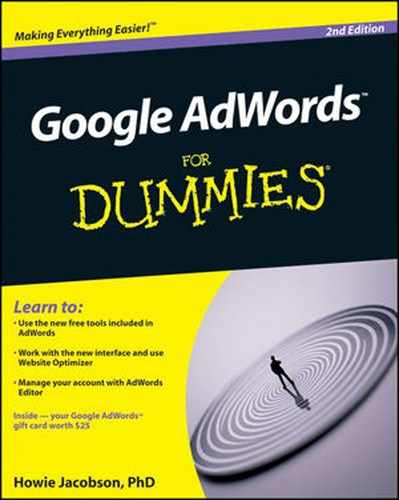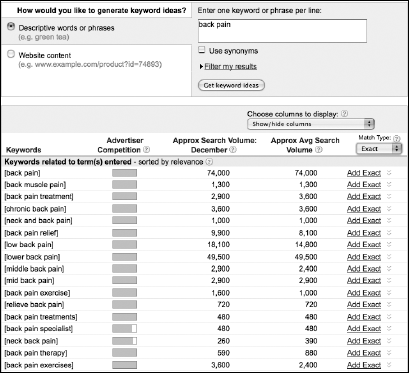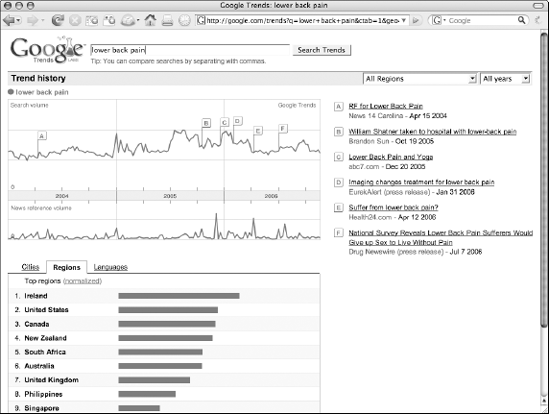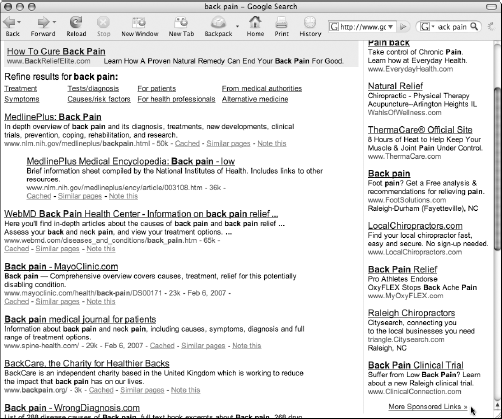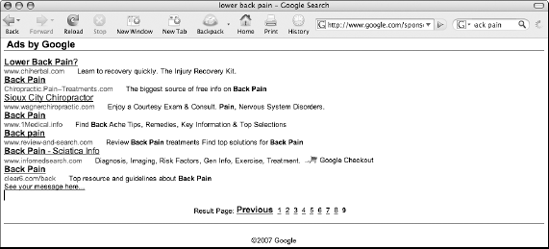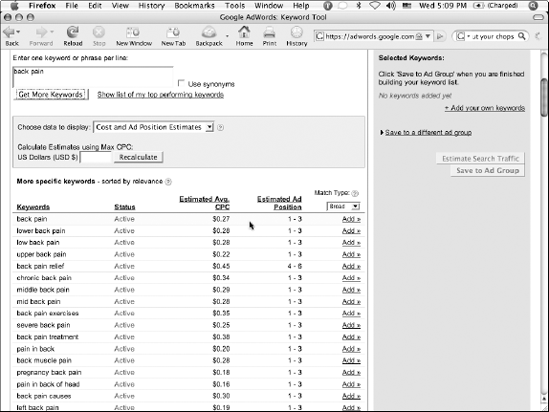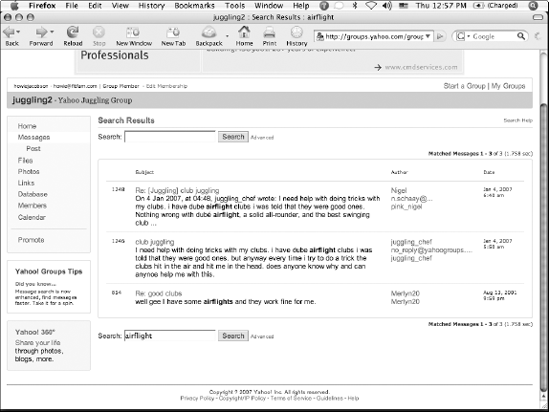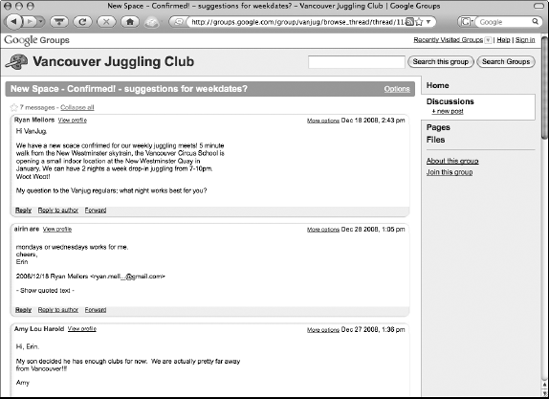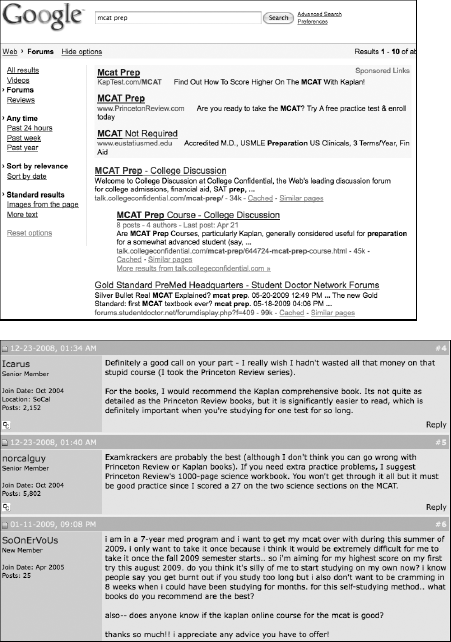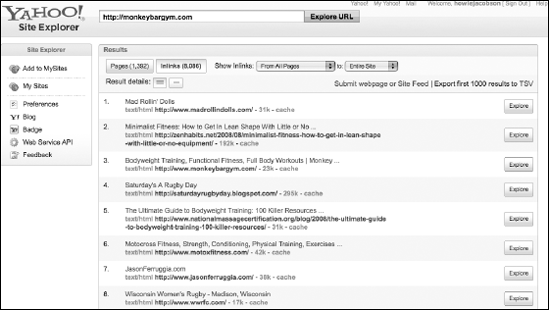Spying on prospects and competitors
Assessing the size of your market
Taking the temperature of your market
Polishing your profitability crystal ball
Understanding buying trends at online stores
Checking out your competition
The Internet is the ultimate spy tool — (ahem) I mean, market-research opportunity. If you know where to look (and you will by the end of this chapter), you can determine pretty precisely how many people are looking for your product, how much they're willing to pay for it, and how much money your competitors are making from those people. You can also see how your competitors are marketing — their ads, Web sites, e-mails, promotions, pricing, customer service — and learn a lot about what works and what doesn't. On the Internet, we're all marketing naked. In this chapter, you'll discover how to become a peeping tom of prospects and competitors. Enjoy the view!
In the movie Field of Dreams, the Ray Kinsella character builds a baseball diamond in his Iowa cornfield based on a voice that mysteriously repeats, "If you build it, he will come." That philosophy made for a great movie, but I don't recommend it as a customer-acquisition strategy. If you build it, you'll probably end up with a garage full of it — unless you take the time to figure out whether anybody's going to want it enough to pay for it.
Ken McCarthy, creator of The System Seminar for Online Marketing (www.thesystemseminar.com), once asked during a lecture, "If you were an Olympic diver, what would be the most important skill you could possess?" The answers varied — the ability to hold a triple gainer, strong core alignment, powerful legs, and so on — but Ken kept shaking his head no to each try. Finally, when we were getting really frustrated, he shared his answer: "The ability to tell if there's enough water in the pool before diving."
In other words, find out whether there's a market before you commit large amounts of time and money to creating a business or a product (or to learning fancy marketing tricks to attract buyers). As Perry Marshall points out, amateur marketers create a product and then look for people to sell it to — whereas professional marketers find customers and then look for something to sell them.
Whether you're starting a new venture online or you have an existing business that you're looking to expand online through AdWords, don't spend any time writing ads, creating Web sites, sourcing products, setting up factories, hiring employees, or printing letterhead until you've looked into the pool and determined that you can dive without hitting the concrete floor at 60 miles per hour.
In the old days of business, that sort of market research was a drag. Labor-intensive, expensive, imprecise, and slow. But if you want to sell online through paid search, you can save yourself months of agony and thousands of dollars in less time than it takes to fly from Bath, New York to Bath, England.
Glenn Livingston, a former consultant to Fortune 100 companies, has been doing online market research on a do-it-yourself budget with impressive results: He's entered 12 online markets and achieved profitability quickly in all 12. That's quite a batting average, considering that 78.6 percent of all new businesses fail within six months. (See Conveniently Making Up Statistics For Dummies for a full explanation of this calculation.) Considering that Glenn offers seven hours of free audio training on his state-of-the-art market-research techniques at www.ultimateadwordsresearch.com (which you should take advantage of), I'm glad he could boil down those techniques to five critical factors for inclusion in this book:
Tip
"Traditional marketing wisdom says you make your money when you choose your market. Any fisherman will tell you that the best rod and bait in the world won't do you any good in a mud puddle, so let's talk about how to find the best fishing holes.
"While there are literally dozens of factors to consider when choosing a market, here are four of the absolute most important things to know before you go fishing ...
"How big is your market? (Market Size)
"How much is the average visitor worth? (Average Spend)
"What's the total dollar volume? (Market Size x Average Spend)
"How stable is the market? (Market Stability & Trends)"
"Are you willing to do what it takes to get into THIS market?"
"Look at your competitors. How much personal contact are they offering? Do they only offer an e-book with electronic download and no live-chat or 800#, or are they offering done-for-you services with personalized account reps and a massage for every customer? As a market gets more competitive, it moves from the former to the latter, and you have to be willing to jump in at an equal or better level of service than your competitors, or you'll drown. Similarly, if everyone else in the market is providing a high end, $1,000 product with a 50 percent margin, it's going to be nearly impossible for you to get in with a $97 information product. Even if you're the world's most efficient and creative AdWords advertiser, they'll be able to outspend, and therefore out-market you."
Glenn boils down initial market research into one key question: "Are other people making money there?" Because the Internet is so decentralized, nobody knows exactly how big and juicy a given market is. And, as the diet ads say, individual results may vary. Glenn created some guidelines that allowed him to evaluate a market on a lazy Sunday afternoon, and have a very good idea of the potential profitability of the market by dinnertime.
Warning
Remember when your high school Social Studies teacher got mad at you for skipping all the comments on your essay and just flipping to the letter grade on the last page? You're about to discover why — in the case of PPC (pay-per-click) marketing, the letter grade — the potential profitability of the market — can get you into a lot of trouble if you don't understand the data behind it. For example, certain markets can be profitable for advanced marketers and not beginners. Some markets can produce good results with a dozen keywords, while others require tens of thousands. No tool can ever replace your own judgment.
Want to know how many times people searched for keywords related to your business last month? How about which keywords were the most popular? And suppose you could do it in about 20 seconds — are you willing to spend the time before setting up your AdWords campaigns?
The number of searches is a critical number if you plan to make AdWords a significant part of your business acquisition strategy. Think Yellow Pages — if no one is looking for the listing Unicycles, a unicycle shop that relies on the Yellow Pages is going to have trouble paying the rent. Of course, many items and services are sold that aren't searched for — just not with AdWords. For example, lots of people buy CDs with guided meditations. But very few people searched for them (about four per day), so you could reasonably expect one sale every one to two months from AdWords traffic if your ad and Web site were very good. And with that tiny trickle of traffic, your testing of alternate ads (see Chapter 13) and landing pages (Chapter 15) will provide conclusive results some time around the next ice age.
Use Google's Keyword Tool (here's a shortcut: www.askhowie.com/kwtool) to discover the popularity of the search terms in your market. When you navigate to the Keyword Tool shortcut, here's all you have to do:
Tell Google what language and geographic location you're curious about by clicking Edit link next to the default options.
Make sure the Descriptive Words or Phrases radio button is selected.
Type your main keyword into the search box.
Deselect the Use Synonyms option.
You'll want to include synonyms as you build your keyword empire, but right now, focus on the main keyword family.
Type the squiggly characters into the box below to prove you're a human.
Click the Get Keyword Ideas button.
Google gives you a list of the top keywords that include the words you typed, as shown in Figure 4-1. In the last column, Match Type, choose Exact from the drop-down list. You see the number of times each keyword phrase is searched on Google, during the previous full month and on average. Click the Approx Avg Search Volume header to sort by average monthly search volume, from greatest to least.
Scroll down to the end of the list (but before Additional Keywords to Consider) and download all the keywords by clicking the text, the .csv (for Excel), or .csv link. (If you have Excel on your computer, choose the Excel option.) A download window appears, allowing you to open the file directly or save it to your hard drive. When you open the spreadsheet, you see a column of keywords and three additional columns: Advertiser Competition, Approx Search Volume: December (or whatever the last month was), and Approx Avg Search Volume. The last column is the one you're most interested in right now. For later searches, you'll include data on average cost per click and estimated ad position by selecting those columns from the Choose Columns drop-down list above the keyword list.
Quickly scan the keywords and delete any rows unrelated to your market. For example, if you sell books and supplies to rabbit owners, remove irrelevant terms, such as Velveteen Rabbit and Who Framed Roger Rabbit, from the list. Examine the remaining keywords, paying attention to several things:
Which keywords are more popular (higher on the list) than others?
Are there just a few keywords that result in the vast majority of searches?
Do some of the keywords represent sub-markets within the main market (for example, rabbits for hobbyists versus rabbits for commercial purposes — pets or meat)?
Figure 4-1 shows that people searched for back pain 74,000 times the previous month. The top related terms include lower back pain (49,500), low back pain (14,800), and back pain relief (9,900). This information is helpful — not just now, while you're assessing the potential risks and rewards of entering the market, but later on, when you choose keywords and write sales copy. For example, more than three times as many people searched for lower back pain than low back pain. If you're writing the headline of a Google ad promising relief from back pain, that information would lead you to choose lower back pain as the term that mirrors the language of your market. You'd also use that information to create the copy on your Web site, and in offline marketing materials such as brochures, print ads, business cards, and so on.
The total number of searches for these keywords, which you can calculate in Excel by selecting the cell below the final entry in the Approx Avg Search Column and hitting the Autosum button (Σ) in the Standard toolbar, is a good indication of whether it's a good market to enter.
Most smart businesses will spend money on customer acquisition until they reach the break-even point. If you know that every time a Google user visits your Web page, you make 35 cents (on average, not for every single visitor) and you have the ability to sell additional products and services to that customer in the future, you'd probably be willing to pay 35 cents to get the Google user to visit. That is, you're willing to break even on the first sale to gain a valuable business asset: a customer with whom you can build a relationship. (Chapter 14 celebrates the break-even concept to your heart's content.)
Tip
If you're selling a product that promises customers will save or make money by using it, you can usually charge more for it than if the product doesn't promise financial reward. It's hard to translate money into happiness. It's easy to compare the price of the product (say, a $750 AdWords telephone consultation with me) with the thousands of dollars you'll save on your AdWords campaigns. That's why marketing consultants make more than life coaches. Keep this distinction in mind as you explore your markets.
If the average bid is under a dime, you can assume that very few people have figured out how to sell high-ticket or high-margin products or services. For example, about 75,000 people search for home remedies each month, yet the average bid hovers around 10 cents. Home remedy seekers are do-it-yourselfers, looking for cheap and ingenious tips rather than expensive do-it-for-me solutions. Compare that to starting a business, which goes for over two dollars per click. This comparison points out an important distinction between markets: the buying-dollars-for-dimes market versus everything else.
Tip
In some markets, bid prices bear little relation to the value of a visitor. Big companies (which I define as any organization where the person in charge of AdWords campaigns isn't using a personal credit card to pay) tend to overbid. Some businesses are so good at earning money from visitors that they can afford to lose money to acquire a customer. But in general, the average bid price for a keyword gives you a good idea how much a click is worth, on average, to your competitors.
Google doesn't share its bid prices publicly, but you can estimate them using either the Keyword Tool or the Traffic Estimator tool in your AdWords control panel. Both tools are erratic in their ability to predict your actual bid prices, but as long as you're using them to compare markets in a very preliminary "Is this worth my time?" sort of way, you needn't worry about pinpoint accuracy.
By doing a little keyword research and entering your results into the MPG calculator that you can download from www.askhowie.com/mpg, you can assess the Total Market Health (TMH) — man, am I a fabulous acronym builder (FAB) or what? — of your market by combining the total number of bids with a weighted average of bid prices. This gives you a rough estimate of how much money is being spent in the market by PPC advertisers.
The process takes you fewer than ten minutes per market (I've done it so often I can do it in under five minutes), and it looks more complicated than it is. If you've never used a spreadsheet program before, you may want to have an Excel jockey friend on hand to help you the first time. Here's all you need to do:
Go to
www.askhowie.com/mpgand download the MPG Calculator. (I ask for your name and e-mail address in exchange — see Chapter 11 to discover my strategy.)You'll need Microsoft Excel or the free spreadsheet Calc available at
www.openoffice.orgto open the MPG.After you've downloaded and opened the MPG, enter the keyword you searched using the free Keyword Tool.
I describe this tool in the "Determining market size by spying on searches" section, earlier in this chapter.
Enter the total monthly search volume from the spreadsheet with the top 100 keywords into the MSV column of the MPG.
Log in to your account at
http://google.com/adwords.Click the Tools link and choose Traffic Estimator from the Optimize Your Ads section.
From the keyword spreadsheet, select and copy the entire column containing the keywords.
Note
Do not include the search volume numbers, just the keywords themselves.
Paste those keywords into the box at the top of the Traffic Estimator.
Leave Max CPC and Daily Budget blank, select the language and location targeting based on the market you're going after, and click Continue.
Sort the results by Search Volume by clicking the Search Volume column header. Look at the Average CPC for the most searched keywords.
This is Google's estimate of the cost of showing your ad in positions 1–3.
Divide the Average CPC in half and enter that number in the Maximum CPC field. Click Get New Estimates.
Again, sort the keyword list by Search Volume. Keep reducing your Maximum CPC until the Estimated Ad Positions are 4–6 for the majority of your highest volume keywords.
(Keep sorting by Search Volume after each iteration.)
Now take the Average CPC estimated by Google and paste it into the CPC column of the MPG.
The MPG calculates the TMH for the market defined by that broad keyword. TMH is a number between 0 and 5,000 (some markets may top out above 5,000, but that's rare). Try this exercise with different markets, and especially with different variations of your main keywords. Which appears more profitable: car insurance or auto insurance? Back pain or back ache? Beekeeper or apiarist?
What sort of TMH are you looking for? The longer you do this, the better your feel will become, but for right now, you can follow Glenn's rule of thumb: AdWords beginners should enter niche markets with TMHs between 100 and 200. At 200, the markets become more competitive, and below 100, there's not enough money to go around. One exception to this rule is the dollars-for-dimes market. If you're helping people make or save money, you can probably make a go of it with a TMH between 50 and 200.
Tip
Don't get freaked out if Google's Traffic Estimator tool initially predicts very high CPCs — those numbers are the bid prices for the top positions, which you probably don't want, and reflect the "ignorance tax" Google imposes on advertisers who don't follow the strategies you're learning here. (See the "Bid persistence: Will you still love me tomorrow?" section, later in this chapter.)
If Oprah ever reads my hilarious yet touching and wise essay, "Manifesto of an Average Ultimate Frisbee Player," surely she'll invite me to be a guest on her show. For several weeks after this, many people will search online for Oprah Frisbee guy and a few variations. But would it be wise to build a business based on that keyword family? Probably not, because my fame (and it is coming, I tell you) is likely to be fleeting. If your business success depends on short-lived trends or fads, you'll never turn your AdWords campaigns into business assets. They won't be reliable. Similarly, if your market is trending downward (Ken McCarthy discovered that very few people in the 21st century are searching for buggy whips anymore, even though they had been all the rage 100 years earlier), you can't rely on past data.
Luckily, Google publicly shares a tool that allows you to view trends in your market to help you decide whether it's stable, growing, or declining.
Visit Google Trends (www.google.com/trends) and search for the major keywords in your market. Is the traffic stable over the past few years? Trending upward? Good. If it's trending downward, beware. You'll see seasonal cycles in the Google Trends graphs, as shown in Figure 4-2. Don't worry about dips that occur regularly each year. Be worried if the overall graph trends downward.
Aside from being fascinating and addictive (at least for people who subscribe to American Demographics magazine), Google Trends gives you a longer-term picture of your market. Why, for example, did searches on back pain spike in July 2005? I don't know, but I'll bet some chiropractic market analyst has an answer. The Cities, Regions, and Languages tabs provide more useful information. For instance, the Regions tab reveals that 9 of the 10 countries ranked for most back pain searches were part of the British Empire at one point in their history. Coincidence? Maybe.
Sometimes, Google superimposes news headlines on the graph, as shown in Figure 4-3. William Shatner's hospitalization for back pain in October 2005 (point B on the graph) appears to have triggered little additional interest, but the December 2006 ABC news report on lower back pain and yoga (point C) either anticipated or sparked another explosion of interest going into the new year. I don't know what any of this means, but if I were selling products to help your aching back, I'd spend a lot of time looking at graphs like these. And whatever your market, I recommend you do the same.
The search data described in the preceding section represents the demand side of your market. The following sections look at the supply side — information about the businesses selling in that market, and how much they're making.
To continue paying homage to Ken McCarthy's swimming-pool metaphor, it's not enough for the Olympic diver to be able to tell that the pool contains 660,253.09 gallons of water. If the water is frozen solid, diving in isn't a good idea. If the market consists of hundreds of thousands of monthly searches but no buyers, you're diving in a frozen market — and it won't feel good when you land on your head (or your empty wallet).
The average bid price, which I describe earlier in this chapter, is one indicator of the responsiveness of a market. But this issue is so important that you should take some time and corroborate your first impression with several other data sources.
In the popular imagination, entrepreneurs get rich by creating products and services that nobody else has ever thought of. In real life, that rarely happens. Truly original products and services often languish for years until they catch on. Rather than celebrating when you discover that no one else is selling what you want to sell, you should become somber and a little nervous. Then take a deep breath, relax your shoulders, and continue with your day. (I didn't want to leave you all nervous and tense — you might get back pain, and I'm not selling anything in that market. Much better for me if you get gout.)
Go to www.google.com, search for your keyword, and count the number of sponsored listings. You can do this by clicking More Sponsored Links just below the column of AdWords ads on the right (see Figure 4-4). The first ten listings appear on that page. Click the Next button at the bottom to bring up listings 11–20. Keep clicking Next on each subsequent page until you run out of Next links to click. Figure 4-5 shows the end of the long line of ads for the keyword lower back pain. Seven ads on result page 9 translate to 87 ads.
Tip
For some reason, Google doesn't always display the More Sponsored Links link the first time you search. Refresh the page until that link appears by choosing View
You'll see slightly different results depending on your geographic location — a number of listings in my example were for local chiropractors — but the general trend will be clear.
Glenn Livingston (www.ultimateadwordsresearch.com) cautions AdWords beginners to avoid competing on keywords with more than 25 competitors. After you've cut your teeth in less competitive markets, you can begin to assault the lofty domains of high profit. After all, if someone's doing well there, why not you?
Beware of markets full of here-today-gone-tomorrow advertisers. After all, advertisers are trying new things all the time, thanks to Google's no-commitment, low-cost model. Just because you can gather more market data on a Sunday afternoon than Procter & Gamble could amass during the entire Carter administration doesn't mean the data is stable. Bids especially are vulnerable to sudden change because each bid represents not an entire market segment but one merchant's decision that day.
A simple way to establish bid persistence is to print the first two pages of the sponsored listings and then print the listings again at least three weeks later. To reduce your risk as much as possible, repeat this exercise again three weeks after that. If you see that the listings are stable over those six weeks, these folks are either very careless or they're making money.
Earlier in this chapter, I describe how to use the Keyword Tool and Traffic Estimator to assess Total Market Health. Now I show you how to use the Keyword Tool to figure out whether you can afford to use AdWords to test your initial sales process. Google is famous for being wildly inaccurate in predicting your actual bid prices because your actual bid depends on the quality of your Web site (as well as on the invisible hand of capitalism). The Keyword Tool, like the Traffic Estimator, gives you a dollar amount based on the history your competitors have amassed, which makes it more, not less, valuable at this point in your research.
To use the AdWords Keyword Tool within your account, follow these steps:
Log in to your AdWords account, click the Tools tab, and then select Keyword tool from the drop-down list.
Enter your main keyword and enter click the Get Keyword Ideas button.
In the Choose Columns to Display drop-down menu, select Show Estimated Avg. CPC and Show Estimated Ad Position.
Figure 4-6 shows the estimated CPC for back pain and — hundreds of related keywords — as well as the position you can expect for that CPC. If your default CPC for that ad group is too low, enter a higher Max CPC in the box and click the Recalculate button. You can also enter smaller CPCs and recalculate to find out how little you can expect to pay for various positions. The lower the CPC, the less profitable it's been in the past for other AdWords advertisers. You're looking for a sweet spot, where the Max CPC is low enough that you can afford to pay for enough clicks to test and improve — and high enough that you can be sure others are making money in this market.
Another source of Internet market data are the popular online stores. To different degrees, they reveal what their merchants are selling and/or what their patrons are buying.
Many online merchants conduct business using PayPal as their Web host and merchant account. PayPal graciously provides you with revealing glimpses of their bloomers by listing the sales numbers each shop has made (which is one reason not to use PayPal shops if you're in a competitive market).
To score this data, go to www.askhowie.com/paypalshops, enter a keyword and search for shops, or browse the category listings on the left, just below the search box (see Figure 4-7). In most cases, the category listings are too broad to help you assess the strength of a niche market. You can see 16 pages of PayPal shops — at 25 listings per page, that's a minimum of 376 merchants selling products related to back pain.
Spend some time looking at which merchants are making the most — and fewest — sales. Mattresses and magnetic wraps (passive devices) seem to be more popular than hypnosis products and advice (products that require active participation). Save yourself the grief of creating another failing online store by making sure that at least a few people are making sales of products similar to yours.
Remember way back when Amazon.com was just a bookstore? Now it sells electronics, kitchen gadgets, outdoor furniture, clothes, shoes, musical instruments, groceries, jewelry, sporting goods, toys, and pretty much everything else that can be put in a box and sent by UPS. Amazon has succeeded partly because it analyzes every bit of customer data it collects. If you've shopped at Amazon before and you have its cookie on your computer, it'll show you a home page calculated to vacuum the maximum amount of money from your wallet, based on what it thinks you'll want to buy next.
You want to search Amazon anonymously — so if you, too, get a personal greeting from Amazon (and you thought you were special, huh?) — so click the link at the top that says If you're not Jack Bauer, click here. On the sign-up page that follows, don't fill in anything. Instead, click the Amazon.com tab at the top left to re-enter the site as a stranger. Now, when you search, Amazon won't filter the results based on your shopping history. Instead, it'll serve you the most profitable products in each category.
Note
A cookie is a tiny piece of code that a Web site stores in your computer so the Web site will recognize you in future visits. Amazon always greets me by name when I log on and shows me the items I looked at last, along with new recommendations. If I delete all my cookies in my Web browser Options or Preferences menu, the next time I show up, Amazon will treat me like a new customer, about whom it knows nothing.
As in PayPal Shops, you can type in a search term or just browse by category. A category search of Exercise & Fitness (see Figure 4-8) shows the three most profitable products front and center: a stationary bicycle, a treadmill, and an elliptical trainer. On the right, it offers a low-cost item (a yoga mat) and a slightly higher-priced step system.
Drill down into categories and subcategories to see what Amazon knows it can sell in each market niche. You can also search by keyword; a search for back pain on the entire Amazon.com site (as shown in Figure 4-9) displays, on the left, 28,000 books, 1,436 products in Health & Personal Care, 211 items in Sports & Outdoors, 88 in Home & Garden, and so on. Click each category to find the bestselling items within it.
I want to see what's hot in Health & Personal Care related to back pain. When I click that category, Amazon shows me the most popular items it or its partner stores carry (see Figure 4-10). In this case, it's a Spine-Worx Back Realignment Device, a Body Back Buddy — which presumably can double as a coat rack — and lumbar support for the cheap desk chair your company buys because ergonomically sound chairs cost too much.
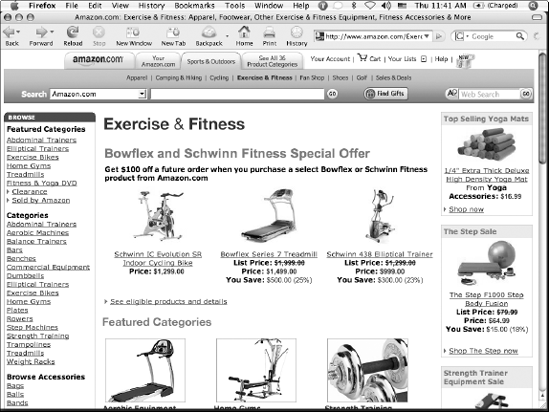
Figure 4-8. Shopping anonymously at Amazon.com puts millions of dollars of market research at your fingertips.
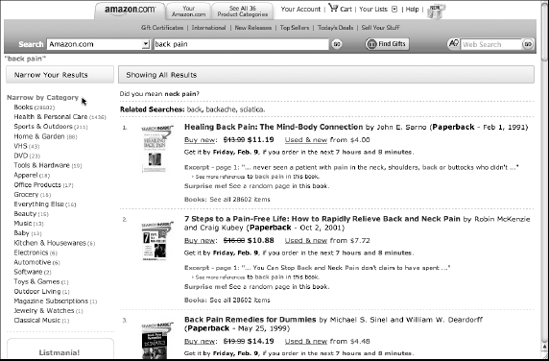
Figure 4-9. When you search anonymously by keyword at Amazon, you get all its bestselling items at your fingertips.
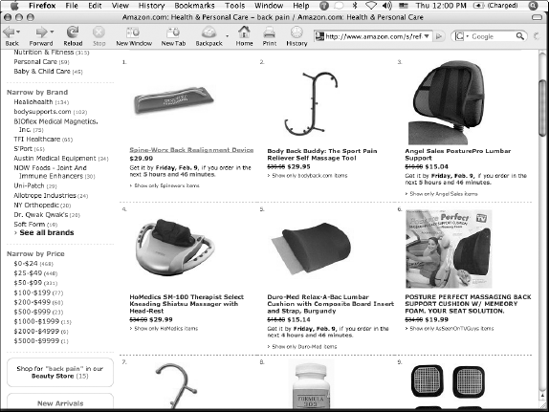
Figure 4-10. Amazon tells you exactly what's hot by putting it on the first page of the search results.
Tip
You might be tempted to throw in the towel if you see the product you want to sell, or a very similar one, listed on Amazon for 30 percent less than you can buy it for. Don't worry — you have a huge competitive advantage over Amazon if you've chosen a specific market niche. Amazon will bid on AdWords, but your ads will be better. Your campaigns will be more efficient and more tightly targeted, and you will understand your customers' fears and desires better than Amazon does.
Note
The bottom line of all your research is to answer the question, "Are people making money online in this market using PPC?" If the answer is no, let go of this market for now and repeat the research process with a different market.
If the search volume is high enough and the customers are ready to spend money, you're ready to go to a higher and more intensive level of research to find out what your prospects want — and what drives them crazy about their current situation.
The size and temperature of your market tell you whether to enter that market. Knowing how many people are searching and buying doesn't help you market to them yet. You just know they're out there, poking around and buying stuff from your competitors. The next three research questions guide you to develop the right product and sell it using the right concepts.
Your future customers will tell you what they want to buy, how they want to buy it, what color and size and shape it should be, what kind of delivery options they prefer, and how much you should charge for it. They'll talk for hours about what bugs them about other options and what the perfect solution to their problems would be. All you have to do is find out where the conversations are happening, sit down, and start listening.
Remember those nature specials on public television that show all the animals gathered around the watering hole in the savannah? They're all hanging out, drinking, socializing, eating some grass, and sharing the day's gossip. Your market has a watering hole where your buyers gather, too. If you want to find out what to sell to your market and how to sell it, you have to hang out at the watering hole.
Your market's watering hole is where your prospects come to gather information and develop relationships that will help them in their business. The offline component of a watering hole includes lunches, golf meetings, conferences, phone calls, trade journals, water cooler gossip (a literal watering hole!), and the daily routines of business. The online component has two big parts: online groups and the Blogosphere (a cool word meaning the world of blogs).
The two big providers of free groups are Yahoo! and Google. Spend some time on each site, searching for groups related to your keywords and your market. Join the most active groups, read the message archives, and follow the daily threads. Verify that the people in the groups are your prospects.
Warning
Resist the urge to do any selling in these groups. You're at their watering hole, remember? If you start pitching your product or services, or contribute comments that are off-base or self-serving or unhelpful, you've just identified yourself not as a zebra, giraffe, springbok, or wildebeest, but as a crocodile! If you want to come back and sell to these groups later, after you've mastered their jargon and understood their concerns, they'll freeze you out if you pushed too hard at the beginning.
Begin at http://groups.yahoo.com. To join Yahoo! Groups, you need a free Yahoo! account. If you don't yet have one, you'll be prompted to create one. You can start searching for groups without an account, but you'll need to create an account before you can join a group. If you have a Yahoo! account, log in and start searching. You can apply to join groups right away.
After you've done some searching, you'll discover why Google, not Yahoo!, is the preferred search engine. Yahoo! focuses exclusively on keywords, and ignores meaning and context. When I typed Juggling into the Groups search box, the first two groups listed (as shown in Figure 4-11) were a support group for work-at-home moms and another for Christian homeschoolers with more than two children. They were in the top positions not for relevance, but because they were the two largest groups that had the word juggling in their description. Both groups, of course, used the term juggling metaphorically. So neither is a particularly useful watering hole to learn about your prospects' views on replaceable wicks for juggling torches or the proper weight of a silicon stage ball. The next three groups, however, are closer to the mark: a group dedicated to Contact Juggling, a group of Christian clowns, and the main Yahoo! juggling group. The Contact Juggling group's archives are public, whereas the other four groups require membership.
In addition to the keyword search, Yahoo! also gives you a directory of categories that may be more useful. At the top of Figure 4-11, you can see the categories Hobbies & Crafts > Hobbies > Juggling. Click Juggling to view 192 different juggling-related groups. The first two groups look familiar. When you click Juggling2, you're taken to the group's home page, where you can read a description of the group, see how active the members are (by viewing the message-history chart), and decide whether it's worth your time to join this group. To join, click Join This Group! on the right. On the next page, select the e-mail address you want linked to this group, choose how you want to receive messages (individual e-mail, daily digest, or Web only), select the e-mail format, copy some text to prove you're a human and not a software program, and click Join. I recommend choosing the daily digest over individual e-mails — if it's an active group, you could easily spend your entire day dealing with off-topic threads about whether other threads are off-topic and nonsense like that. You can always change your preferences after you've joined, and you can also quit any group easily.
After you join, you can read through the archives and view profiles of group members. Figure 4-12 shows posts in the Juggling2 group.
If you wanted to launch a competing product to the Dube Airflight Clubs, you could gain valuable insight into what people like and don't like about them. The posts shown in Figure 4-12 indicate that clubs striking in midair is a problem for some jugglers.
If you wanted to (say) sell against Airflight, you could create thinner clubs less likely to bang into each other, or softer clubs that wouldn't hurt so much if they hit people in the head. And you'd save this post in an idea file for when you started writing AdWords ads. You might come up with an ad that targets the problem you found:
Clubs hitting in midair? Tired of getting bonked on the head? Try Thin and Soft Juggling Clubs www.SoftThinClubs.com
To search Google Groups, go to http://groups.google.com. Google Groups hasn't been around as long as Yahoo! Groups, so you won't find Google communities as established as the Yahoo! ones. But Google Groups gets direct feeds from many of the independent Usenet groups that have existed since the late 1980s, and so provide much more comprehensive coverage of the market. When you search Google Groups for juggling, you don't get the irrelevant listings that Yahoo! served up. The first groups Google shows you are a unicycling group, a non-Google group dubbed rec.juggling (which I talk about in a minute), and a discussion list for the Vancouver Juggling Club (as shown in Figure 4-13).
To join a Google Group, click Apply for Group Membership on the right. If you're logged in to your Google account, you're taken to a sign-up page where you choose your e-mail delivery schedule, provide a nickname, and apply.
After you've been approved for membership, you can read and reply to messages, search the message archive by keyword, and post new questions. Google formats its group messages on the Gmail template — meaning that replies are kept next to the original message in chronological order.
The Yahoo! Juggling Group moderator sent a welcome e-mail informing me that the group doesn't get much activity these days, and if I wanted to be in the thick of the juggling watering hole, I should try www.jugglingdb.com/news, a portal to rec.juggling, a forum independent of Yahoo! or Google. In fact, I already saw a link to this group for the Google Groups search results.
The first page of messages on that forum is shown in Figure 4-14.
Even before joining this group, you can read all the posts, search for members by country (useful for figuring out geographic ad targeting in AdWords), and look at the Juggling FAQs and lists of current vendors. If you're starting or expanding an online business, this sort of homework is required if you prefer making money to gambling. And it's so cheap, easy, and quick, I hereby grant you no excuses for not doing it.
Search for your keyword as you would normally on Google. When the results page comes up, click the Show Options link near the top of the page, just below the search box. Google gives you several options for refining your search. Click the Forums link on the left to view forum discussions about your topic. For example, in the top image in Figure 4-15, a forum search for mcat prep turns up some spirited discussions from College Confidential on the best way to study for the medical school entrance exams. The second link brings you to the discussion shown in the lower image in Figure 4-15. If you were selling in this market, these unfiltered discussions would be incredibly valuable in reading the minds of your prospects and marketing effectively to them.
Blogs are great places to learn about your customers because, for some reason, people write blogs like online diaries — little held back, little left to the imagination. When they rant about a vendor or a product they don't like, they go all out. Also, bloggers love to link to and comment on one another's blogs in a particular market space, so true conversations develop. Arguments, discussions, reviews, comparisons — read influential bloggers' posts and you'll quickly feel the pulse of a market segment's desires.
How do you find the blogs and blog posts relevant to your business using? Technorati is the most useful search engine for blogs.
Go to www.technorati.com, and enter your keyword phrase in the search box at the top, and hit Return. Then filter the results on the next page by selecting "A Lot of Authority" from the drop-down list.
This search often returns a list of often-influential blogs that deal with your market. The list in Figure 4-16 shows several blogs that write about home gym equipment. If you're selling home gym equipment, go visit them (by clicking their URL) and find out what they're ranting about and what's tickling their fancy. Pay attention to visitor comments, if any (few comments probably means few readers and not much influence), and follow the blogroll — the list of blogs that this blog thinks is important.
The third listing for Home Gym Equipment is a post called "6 Ways to Create a Great Home Gym For Less." Technorati assigns an authority score of 925 to this blog, which means something only in comparison to other blogs ranked by Technorati.
You should filter the results by authority (a measure of how many other blogs link to that blog) to weed out insignificant blogs. Because the Blogosphere represents a network, you can usually find your way to the center of that network just by observing who's quoting whom. Blogging expert Dave Taylor (of www.askdavetaylor.com) likens the Blogosphere to a giant party. The person in the middle of the room surrounded by gaping hangers-on is probably the most influential person. Sidle over to that group and you'll learn a lot about your market. On the other hand, you can also find blogs that don't link to other blogs, that just try to sell you stuff, that rant and rave but have no influence whatsoever. That's like a person loudly talking at a party, but no one is listening.
Your competitors' Web sites are great places to learn what to do and what not to do. When I talked about bid persistence earlier in this chapter, I advised you to print a list of the top AdWords advertisers in your market three times over six weeks. Grab those printouts now and circle the Web sites that appear on all three pages — both the sponsored and organic listings. It's time to hang out with successful businesses and see what they're up to.
First, look at your competitor's Web site as if you're a potential customer. Can you find what you're looking for? Does the site confuse or bore you? Is it easy to contact the site owner and ask questions? Do you trust the site? Can you order easily?
Note
Remember that the home page may not be the landing page you get to by clicking its ad. Check out its landing page and see how it draws you in — or not. Pay attention to how that landing page connects to the rest of the site. Does it try to make a sale or to capture your contact information? What are the featured products? What are its shipping and return policies?
Also, do other sites link to your competitor's Web site? Google loves sites with a lot of inbound links. You can find out who's linking to a Web site by typing link: and then the URL at www.yahoo.com (for some reason, Yahoo does a much better job of reporting links than Google). The link: search takes you to Yahoo's very useful Site Explorer. In Figure 4-17, for example, link:www.monkeybargym.com returns 1392 linking pages A high number of inbound links helps increase their organic Google traffic — as well as decrease their PPC bid prices by increasing quality score.
But wait, there's more! Don't just float around on your competitors' sites — if you can afford it, become their customer. Get into their sales funnel. Discover how they treat their customers, and whether (and how) they try to grow the relationship. You may discover that their initial sale is a loss leader — that is, they lose money on the front end because they have an effective system for selling additional products on the back end.
Do they send e-mail offers for additional products? Do they give coupon codes for dollars off? Do they request feedback? Do they ship promptly? Does the merchandise do what they say it does?
Tip
So what do you do if your competitors do everything right? Here's a little online marketing secret: Your competitors are also your best potential business partners. If you can figure out how to share customers, everyone can increase profits by promoting different offers to different market segments. You can play nice with competitors only when you can figure out ways to differentiate yourself from them.
You know how big your potential market is. You know how hungry they are. You've discovered what they care about — and what frustrates them about the existing situation and options. You've figured out what kind of pricing structure and market response you need to be profitable. And you've scoped out the competition to see what needs are not yet being filled.
Armed with this information, you're now ready to construct the most important sentence in the life of your business: your positioning statement.
Tip
Marketing master Ken McCarthy (TheSystemSeminar.com) explains positioning this way:
Successful marketing is a multi-dimensional process. What do I mean by that? Remember the three-dimensional chess board featured on Star Trek? Instead of one board and two dimensions, there were multiple boards on different levels and pieces could move up and down in space as well as backwards and forwards.
Many advertisers obsess about THEIR product and THEIR advertising. That's all well and good, but what these business owners fail to include in their calculations is the total space of the market they hope to enter. Rarely do prospects see only your product and your advertising. They're usually aware of other offers that — on the surface — appear similar to yours. Further, because we're all so busy and have so many things on our minds, we don't have a lot of extra processing power to think deeply about any company's offer.
Here's the key: You can't expect your prospects to do any heavy mental lifting. If it's not crystal clear why your offer is unique, it will be added to the rummage sale pile in their minds where all the other products go that they don't quite understand and will probably never buy.
Your goal as a business is very simple: You want your offer to occupy a completely unique place in the cubbyhole system of your prospect's mind and you want to figure out how to telegraph that unique value in seconds.
Better marketing and advertising is not just about building a better mousetrap (or creating a better ad), it's about figuring out where your offer fits in the market space and why you're uniquely qualified to hold a place in it, then communicating that message simply and powerfully, over and over again.
Let me give you two examples of how this works. The ultimate romantic city destination for lovers — what place pops into your mind? Probably Paris.
An innovative computer hardware company that's especially friendly to creative types — which company is already there staking out that space? Probably Apple.
A good rule of thumb is that there's probably only one space per category in everyone's mind. Second place is the same as last place.
Your mission as a smart marketer is to go boldly where few marketers tread and figure out what place your offer can own and then make sure every ad you run reinforces that message. Positioning is the thing that separates the marketers who are standing on the winner's platform from the ones who are perennially treading water.
Your ad copy, your Web site, your e-mails, the way you answer your telephone — all these marketing elements must flow out of your positioning. The easiest way to establish top positioning is to carve a market segment that no one else has claimed. For example, there are many competing merchants in the fitness space. That niche is far too big to attack with limited resources. What about home gym equipment? Also big — and full of established competitors. What about home gym equipment for parents with young children? Indoor playgrounds the size of a home gym that both parents and toddlers can enjoy safely — and that parents can use for a real workout while watching their kids? No company I've ever heard of has told that story before. If your research tells you that parents with young children are frustrated about their exercise options, you may stake your fitness-industry positioning on catering to that market. You may find that your initial idea doesn't fly — they don't have enough room in their house for a gym that big, or they doubt that it's safe for kids. But as you watch the market, you'll discover things they will search for and buy. And your positioning, based on those discoveries, will make you the obvious choice when they see your Google ad.
Ken McCarthy likens online market research to sitting next to a busy road and watching the cars go by. First you find the potholes, by seeing what people want and aren't getting. Then you create products and marketing messages to fill those potholes.
